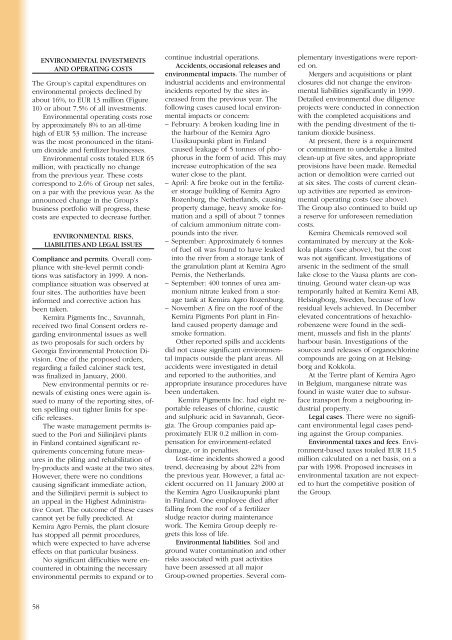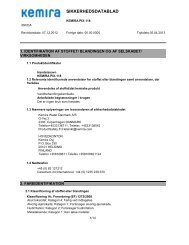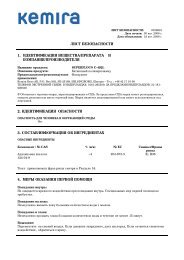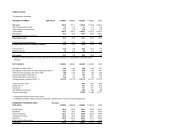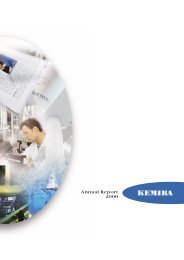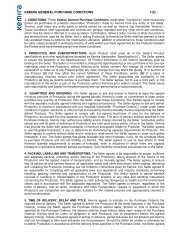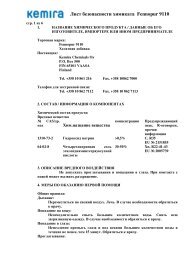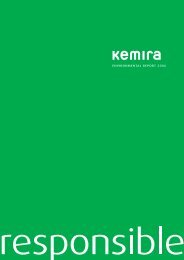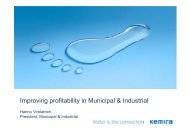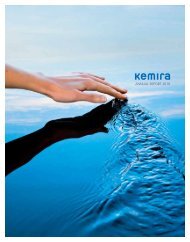Annual Report 1999 - Kemira
Annual Report 1999 - Kemira
Annual Report 1999 - Kemira
Create successful ePaper yourself
Turn your PDF publications into a flip-book with our unique Google optimized e-Paper software.
ENVIRONMENTAL INVESTMENTS<br />
AND OPERATING COSTS<br />
The Group’s capital expenditures on<br />
environmental projects declined by<br />
about 16%, to EUR 13 million (Figure<br />
10) or about 7.5% of all investments.<br />
Environmental operating costs rose<br />
by approximately 8% to an all-time<br />
high of EUR 53 million. The increase<br />
was the most pronounced in the titanium<br />
dioxide and fertilizer businesses.<br />
Environmental costs totaled EUR 65<br />
million, with practically no change<br />
from the previous year. These costs<br />
correspond to 2.6% of Group net sales,<br />
on a par with the previous year. As the<br />
announced change in the Group’s<br />
business portfolio will progress, these<br />
costs are expected to decrease further.<br />
ENVIRONMENTAL RISKS,<br />
LIABILITIES AND LEGAL ISSUES<br />
Compliance and permits. Overall compliance<br />
with site-level permit conditions<br />
was satisfactory in <strong>1999</strong>. A noncompliance<br />
situation was observed at<br />
four sites. The authorities have been<br />
informed and corrective action has<br />
been taken.<br />
<strong>Kemira</strong> Pigments Inc., Savannah,<br />
received two final Consent orders regarding<br />
environmental issues as well<br />
as two proposals for such orders by<br />
Georgia Environmental Protection Division.<br />
One of the proposed orders,<br />
regarding a failed calciner stack test,<br />
was finalized in January, 2000.<br />
New environmental permits or renewals<br />
of existing ones were again issued<br />
to many of the reporting sites, often<br />
spelling out tighter limits for specific<br />
releases.<br />
The waste management permits issued<br />
to the Pori and Siilinjärvi plants<br />
in Finland contained significant requirements<br />
concerning future measures<br />
in the piling and rehabilitation of<br />
by-products and waste at the two sites.<br />
However, there were no conditions<br />
causing significant immediate action,<br />
and the Siilinjärvi permit is subject to<br />
an appeal in the Highest Administrative<br />
Court. The outcome of these cases<br />
cannot yet be fully predicted. At<br />
<strong>Kemira</strong> Agro Pernis, the plant closure<br />
has stopped all permit procedures,<br />
which were expected to have adverse<br />
effects on that particular business.<br />
No significant difficulties were encountered<br />
in obtaining the necessary<br />
environmental permits to expand or to<br />
continue industrial operations.<br />
Accidents, occasional releases and<br />
environmental impacts. The number of<br />
industrial accidents and environmental<br />
incidents reported by the sites increased<br />
from the previous year. The<br />
following cases caused local environmental<br />
impacts or concern:<br />
– February: A broken loading line in<br />
the harbour of the <strong>Kemira</strong> Agro<br />
Uusikaupunki plant in Finland<br />
caused leakage of 5 tonnes of phophorus<br />
in the form of acid. This may<br />
increase eutrophication of the sea<br />
water close to the plant.<br />
– April: A fire broke out in the fertilizer<br />
storage building of <strong>Kemira</strong> Agro<br />
Rozenburg, the Netherlands, causing<br />
property damage, heavy smoke formation<br />
and a spill of about 7 tonnes<br />
of calcium ammonium nitrate compounds<br />
into the river.<br />
– September: Approximately 6 tonnes<br />
of fuel oil was found to have leaked<br />
into the river from a storage tank of<br />
the granulation plant at <strong>Kemira</strong> Agro<br />
Pernis, the Netherlands.<br />
– September: 400 tonnes of urea ammonium<br />
nitrate leaked from a storage<br />
tank at <strong>Kemira</strong> Agro Rozenburg.<br />
– November: A fire on the roof of the<br />
<strong>Kemira</strong> Pigments Pori plant in Finland<br />
caused property damage and<br />
smoke formation.<br />
Other reported spills and accidents<br />
did not cause significant environmental<br />
impacts outside the plant areas. All<br />
accidents were investigated in detail<br />
and reported to the authorities, and<br />
appropriate insurance procedures have<br />
been undertaken.<br />
<strong>Kemira</strong> Pigments Inc. had eight reportable<br />
releases of chlorine, caustic<br />
and sulphuric acid in Savannah, Georgia.<br />
The Group companies paid approximately<br />
EUR 0.2 million in compensation<br />
for environment-related<br />
damage, or in penalties.<br />
Lost-time incidents showed a good<br />
trend, decreasing by about 22% from<br />
the previous year. However, a fatal accident<br />
occurred on 11 January 2000 at<br />
the <strong>Kemira</strong> Agro Uusikaupunki plant<br />
in Finland. One employee died after<br />
falling from the roof of a fertilizer<br />
sludge reactor during maintenance<br />
work. The <strong>Kemira</strong> Group deeply regrets<br />
this loss of life.<br />
Environmental liabilities. Soil and<br />
ground water contamination and other<br />
risks associated with past activities<br />
have been assessed at all major<br />
Group-owned properties. Several complementary<br />
investigations were reported<br />
on.<br />
Mergers and acquisitions or plant<br />
closures did not change the environmental<br />
liabilities significantly in <strong>1999</strong>.<br />
Detailed environmental due diligence<br />
projects were conducted in connection<br />
with the completed acquisitions and<br />
with the pending divestment of the titanium<br />
dioxide business.<br />
At present, there is a requirement<br />
or commitment to undertake a limited<br />
clean-up at five sites, and appropriate<br />
provisions have been made. Remedial<br />
action or demolition were carried out<br />
at six sites. The costs of current cleanup<br />
activities are reported as environmental<br />
operating costs (see above).<br />
The Group also continued to build up<br />
a reserve for unforeseen remediation<br />
costs.<br />
<strong>Kemira</strong> Chemicals removed soil<br />
contaminated by mercury at the Kokkola<br />
plants (see above), but the cost<br />
was not significant. Investigations of<br />
arsenic in the sediment of the small<br />
lake close to the Vaasa plants are continuing.<br />
Ground water clean-up was<br />
temporarily halted at <strong>Kemira</strong> Kemi AB,<br />
Helsingborg, Sweden, because of low<br />
residual levels achieved. In December<br />
elevated concentrations of hexachlorobenzene<br />
were found in the sediment,<br />
mussels and fish in the plants’<br />
harbour basin. Investigations of the<br />
sources and releases of organochlorine<br />
compounds are going on at Helsingborg<br />
and Kokkola.<br />
At the Tertre plant of <strong>Kemira</strong> Agro<br />
in Belgium, manganese nitrate was<br />
found in waste water due to subsurface<br />
transport from a neigbouring industrial<br />
property.<br />
Legal cases. There were no significant<br />
environmental legal cases pending<br />
against the Group companies.<br />
Environmental taxes and fees. Environment-based<br />
taxes totaled EUR 11.5<br />
million calculated on a net basis, on a<br />
par with 1998. Proposed increases in<br />
environmental taxation are not expected<br />
to hurt the competitive position of<br />
the Group.<br />
58


